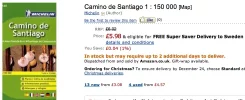Hello everyone!
I'm a rookie preparing to walk the Camino Francés next fall. Being a planning freak, I have spent the last three months reading most of this brilliant forum , following blogs and browsing sites on the internet, going through my local library for camino- or pilgrimrelated titles, and trying out the various available apps - I'm planning to take my iPhone for several reasons. This Friday, Camino candy from the British Isles landed in my mailbox in the form of Sil's Your Camino and the DVD The Way. The massive amount of information available is at times overwhelming, but I love it! I am currently a very happy peregrina-to-be!
, following blogs and browsing sites on the internet, going through my local library for camino- or pilgrimrelated titles, and trying out the various available apps - I'm planning to take my iPhone for several reasons. This Friday, Camino candy from the British Isles landed in my mailbox in the form of Sil's Your Camino and the DVD The Way. The massive amount of information available is at times overwhelming, but I love it! I am currently a very happy peregrina-to-be!
The guidebook (in Swedish) I bought day 1 seemed perfect to me at the time. I now see that it is a bit outdated already (printed 2009) and on the heavy side, even with arts and crafts like page ripping, silhouette cutting and origami (optional) applied to it. January is approaching, and I am currently considering whether I should order the CSJ 2012 or the new edition of the Brierley, that so many members are fond of and seem to bring along on their Camino.
My question is this: Provided that I will learn enough Spanish, and I think I will, the Eroski app contains basically all the practical info on their website, and the Blu Guide ones extra info on culture and history. I don't want to "just" follow the spiders, sorry, the arrows, I love all the extra in-depth info I can get. I also like the thought of a book as a travel companion. Do I need a guidebook? What will taking the Brierley or the CSJ bring to my Camino, respectively? Better maps? More detail? A peregrino perspective?
I am sorry about the extensiveness of this post . That's just me, I guess.
. That's just me, I guess.
Elisabet
I'm a rookie preparing to walk the Camino Francés next fall. Being a planning freak, I have spent the last three months reading most of this brilliant forum
The guidebook (in Swedish) I bought day 1 seemed perfect to me at the time. I now see that it is a bit outdated already (printed 2009) and on the heavy side, even with arts and crafts like page ripping, silhouette cutting and origami (optional) applied to it. January is approaching, and I am currently considering whether I should order the CSJ 2012 or the new edition of the Brierley, that so many members are fond of and seem to bring along on their Camino.
My question is this: Provided that I will learn enough Spanish, and I think I will, the Eroski app contains basically all the practical info on their website, and the Blu Guide ones extra info on culture and history. I don't want to "just" follow the spiders, sorry, the arrows, I love all the extra in-depth info I can get. I also like the thought of a book as a travel companion. Do I need a guidebook? What will taking the Brierley or the CSJ bring to my Camino, respectively? Better maps? More detail? A peregrino perspective?
I am sorry about the extensiveness of this post
Elisabet


















